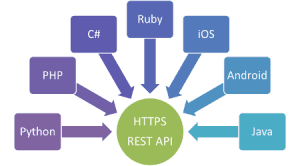Estimated reading time: 4 minutes
 Thank you for reading this post, don't forget to subscribe! Happy New Year 2024!
Thank you for reading this post, don't forget to subscribe! Happy New Year 2024!
In the past few months, I have been focusing a lot of my time around the development of our Nutanix Ready Integrated Program which deals with partner solutions leveragingcosuming our API (application programming interfaces). After a lot of research on API programs and consumption patterns, I thought I would share my thoughts and some conclusions on the business side. Not sure if this is considered a blog post or just ramblings, but here we go.
API and DATA
Data is, in many ways, is one of the most valuable assets a business has. A growing number of consumers and businesses are incorporating web and mobile apps into their daily routines, and companies are using data to provide more personalized, tailored experiences to their customers. In addition, companies are analyzing customer and operational behavior to make better decisions. These are some of the valuable new uses for previously isolated data sources.
APIs have emerged as the most accessible way for consumers within the business to extract value out of that data; developers can use them to create new business opportunities; improve existing products, systems, and operations; and develop innovative business models. Analysts can grab new data sources more quickly and pull the data into their analytics platforms. As the keys to unlocking precious enterprise data, APIs need to be combined with enterprise connectivity to actually free the data from systems. The APIs is the piece that makes the data consumable and reusable, thus they become ever more valuable to business.
API Evolution
As more and more APIs come into use, the architecture underpinning them needs to evolve as well – organizations cannot simply attempt to deploy APIs on top of existing monolithic systems and processes and expect an overnight transformation. Rather, the transformation begins with initiatives targeted at new innovative directions for the organization, such as the embrace of microservices, mobile apps, and laying the groundwork for a world of connected sensors. Also, product companies should consider making API framework a key part of their design strategy which would enable end users to adopt their product more rapidly and aggressively. And above all, embracing APIs will help ensure that these connections are made intelligently and efficiently. With all of this, I’ve seen there’s a direct connection to business value as well – generating revenue is considered the most important value that APIs provide to the business.
While revenue generation is an important part of the story, the impact of APIs goes much further into organizations, enabling transformation and agility at many levels. APIs enable enterprises to deploy apps quickly, in a repeatable way, which leads to a faster pace of delivery, and the ability to create new and innovative experiences quickly. In addition, APIs can greatly reduce the cost of change, enabling IT and application owners to change apps with minimal impact – especially when there are numerous back-end integrations involved. This is critical to agility since for the most part, the pace of change of the front end applications is much faster than in the back-end applications. APIs also help enterprises achieve operational efficiency, enabling greater visibility and expanded capabilities since every API call from the mobile app to the backend system is tracked and traced through an API key.
What are some examples?
For those who are not familiar with API, some examples are API are like SOAP or REST. Nutanix uses REST (representational state transfer) based API, and we allow partners and customers to build leverage our API to do some very cool things. From VM monitoring to solution orchestration, the possibilities are endless.

For example, Comtrade, a Nutanix Partner has developed a System Center Operations Manager Management Pack for Nutanix. It leverages our API to pull metrics into SCOM to correlate with application workloads into a single pane of glass. In this scenario, an IT Pro can really understand where his bottlenecks are and take action or automate that action. Now that is the power of API with some DevOPs mixed in!!
To summarize….businesses from every industry are using APIs to add additional value, from increased revenue to increased agility to improved customer experience. Extraordinary changes are taking place in the enterprise which necessitates a new organization and philosophy for utilizing technology.
In a future blog post, I plan to go into the technical aspects of API and use cases.
Until next time, Rob… 🙂
